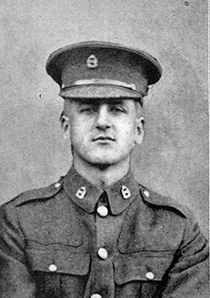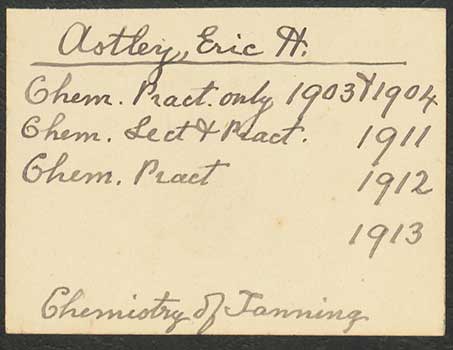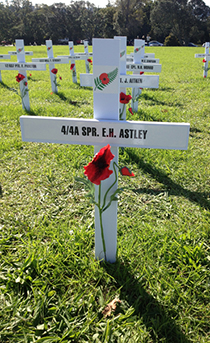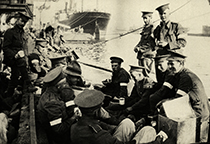
Unidentified New Zealand Engineers breakfast on the wharf at Alexandria on 16 April 1915 before boarding the Goslar.Accession No. 2001.215, Kippenberger Military Archive, National Army Museum Te Mata Toa, Waiouru.
'He lies in the Aegean, between the islands of Imbros and Samothrace and the Gallipoli Peninsula. The sea is very blue and clear, and the sun sinks majestically behind Samothrace and spreads the most glorious colouring over land and water. Eric, who loved the beautiful, enjoyed those sunsets, and seeing it has been his fate to fall as a soldier, I am sure he would have been pleased to rest where he lies.'
Aubrey Williams writing to Astley's parents.New Zealand Methodist Times, 4 September 1915, p.5.
Egypt and Gallipoli
In December 1914, the British Section shipped out to Egypt and joined the Main Body of the NZEF at Zeitoun Camp near Cairo. There the Section was disbanded and the men divided between an Engineer Field Company and the Army Service Corps; Astley joined the No. 1 Field Company, New Zealand Engineers as a sapper.
Heat and dust-storms aside, training conditions in the desert around Zeitoun were ‘… almost too ideal’ for the sappers as bridges were readily built on the regular irrigation canals and digging trenches was easy in the `loose, convenient sand.’ They would face very different conditions at Gallipoli.
The Company took part in the landing at Anzac Cove on 25 April 1915, going ashore late in the afternoon from the Goslar, a captured German vessel.
‘Men leaped into the water and after landing picks, shovels and other gear, the Field Company was lined up in the shelter of a cliff while arrangements were made for their immediate employment’. Some of the Company set about digging support trenches on Plugge’s Plateau while others prepared gun emplacements and built machine gun posts.
By 27 April, the Company was split between Quinn’s Post, where they alternated between frontline duty and creating communication and firing trenches, and Walker’s Ridge, where the sappers worked to improve earlier trenches but ‘…were soon forced to drop their shovels and help to repel a determined attack’.
Historian Ian McGibbon says, `For the sappers there was no respite when not working on such dangerous forward positions: communications had to be extended, dugouts built, wire entanglements laid, and water found for thirsty troops.’
In May 1915, Astley was `slightly wounded’ working at Quinn's Post on the ridge of Shrapnel Valley. By early June he would have enjoyed a few days’ respite on the beach along with the rest of his Company after it was relieved of frontline duties by the Australian Engineers.
On 23 June 1915, Astley was making wire screens with other sappers at Shrapnel Point when a shell landed in their shelter, killing three instantly and wounding others, including Astley. ‘Eric was at once removed in an unconscious state to the dressing station, and afterwards was placed on a boat for removal to the Hospital Ship, but he passed away before reaching it.’
It was from the hospital ship the Gascon that Eric Astley was buried at sea.
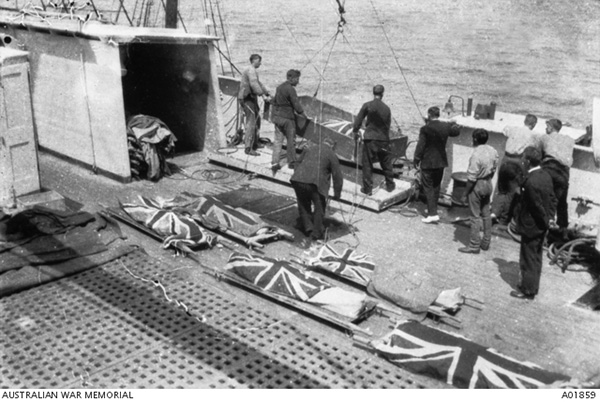 ‘Bodies of the dead on stretchers covered by Union Jack flags being transferred from the decks of the hospital ship Gascon to trawler for burial at sea. 1915.’ Australian War Memorial A01859.
‘Bodies of the dead on stretchers covered by Union Jack flags being transferred from the decks of the hospital ship Gascon to trawler for burial at sea. 1915.’ Australian War Memorial A01859.



